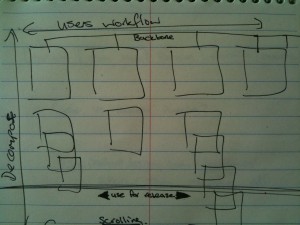2016 Update: Forget about my attempt below and try this user story mapping add-on for JIRA:
User Story Map for JIRA
I received a great question from a customer today regarding user story mapping:
Quick q, are there any plans / thoughts on adding a higher level board for User Story Mapping ( vs. releases etc ) based on Jeff Patton’s work / ideas. We are struggling to communicate at a higher level epics vs stories vs projects vs priorities and after giving this a try ( manually using cards ) it appears to be really powerful.
The customer goes on to share that they are looking at using Easy Agile User Story Map for JIRA, an add-on for JIRA and GreenHopper. I wasn’t aware of this add-on previously so it was cool that the customer brought it to my attention.
- something you do at the start of a new project/epic, rather than an on-going task
- very collaborative with the whole team getting involved, walking around, creating paper prototypes and so on





